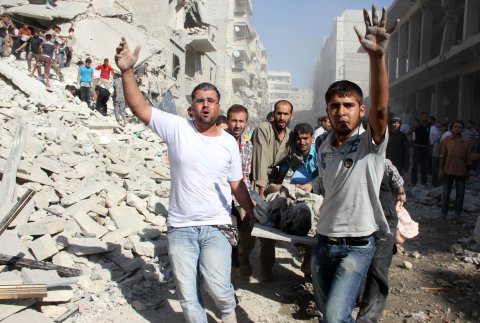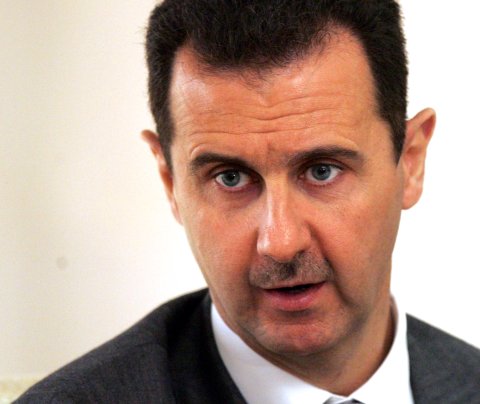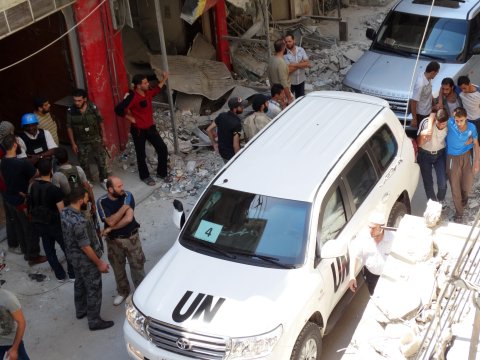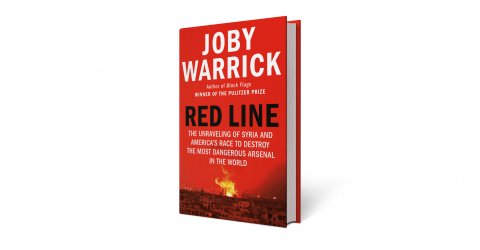Pulitzer Prize-winning Washington Post national security reporter Joby Warrick's new book Red Line: The Unraveling of Syria and America's Race to Destroy the Most Dangerous Arsenal in the World tells the story of America's mission to try to find and destroy chemical weapons in Syria and defeat ISIS. In this excerpt, Warrick tells the incredible story of the U.N. team of investigators who were already on the ground in Damascus to investigate other alleged abuses when on August 21, 2013, a new series of attacks was waged in villages around the capital—killing at least 1,400 in what would become known as the deadliest chemical weapons atrocity in a generation. Warrick's account also identifies one reason President Barack Obama did not intervene after Syria crossed his infamous "red line"—the presence of the inspectors themselves, who could be put in harm's way.

The artillery barrage began in the wee hours, just after 2:30 on the airless morning of August 21. Even from their Damascus hotel rooms miles away, the U.N. investigators could sense that this one was different.
The firing was coming from the hills just to the north, and the projectiles—bright streaks against the black sky—were arcing over the city's ancient quarter and landing a few miles to the east. The view from the Four Seasons' upper floors was mesmerizing: flashes of light, like distant fireworks, and the muffled booms of explosions. There was a long pause, and then a shift in direction, with the shells passing to the southwest, until nearly dawn. The early light revealed distant smoke plumes, but these, too, were different. Instead of rising, they were flat and low to the ground.
Åke Sellström, a Swedish scientist and leader of the U.N. team, rolled out of bed and instinctively turned on the television. There was breaking news coming out of Damascus—this same Damascus—about a horrendous attack with massive numbers of casualties somewhere in the capital's outskirts. The images that flickered across the screen were almost beyond comprehension: Dozens and dozens of victims, lying dead in rows, including children and toddlers still in their pajamas. Curiously, none had visible injuries or wounds, but nearly all were soaking wet, as though they had been doused with water.
Far worse were the images of the injured. The camera zoomed in on a tiny girl who lay gasping softly, like a fish unable to breathe and too far gone to struggle, while a man gently dabbed at a clot of foam that had formed over her mouth and nose. Near her, a boy of perhaps 7 or 8 was twitching violently, his small arms flailing as though trying to beat back an invisible foe.
The newscasters were speculating about poison gas, but Sellström, an expert on the physiological effects of nerve agents, knew very well what had happened. Just three days earlier, Sellström and his 20-member team of inspectors and assistants had entered the capital to investigate allegations that combatants in Syria's civil war had used chemical weapons—including deadly nerve agents such as sarin—in scattered attacks around the country. Dozens had died, most of them civilians. Sellström had tried to convince President Bashar al-Assad's government to allow his team to visit the affected villages and gather evidence. The Syrians had refused. After three frustrating days, negotiations had reached an impasse. The Swede had gone to bed believing his mission was over.

Now someone had launched a major chemical weapons attack on the suburbs, no more than 5 miles from his hotel. They had killed and injured scores of civilians, and perhaps more. Indeed, the toll would prove to be staggeringly large: at least 1,400 dead, including more than 400 children.
And it happened at the precise moment when a body of U.N. experts was present in Syria to document the deed.
"We Go In"
As U.N. headquarters in New York awakened to news of the attack, Sellström received instructions to keep quiet. The precise nature of the horrific crime in the Damascus suburbs was not yet clear, and U.N. officials needed time to gather facts and assess their options. But Sellström could not help himself. This is so horrible, we need to do something, he thought. He walked up to a bank of news cameras in his hotel lobby and made an unscripted appeal: Governments around the world should demand an immediate U.N. investigation. "Write or call the secretary-general," Sellström urged.
From Washington, meanwhile, the Obama administration was beginning to exert pressure of a different sort. President Obama and his team had ordered preparations for a military attack on Syria within days, but the U.N. team stood in the way. If the strike plan moved forward, the investigators might well be injured or killed. They could be used as human shields, or become hostages of a suddenly vengeful Assad.
Obama personally implored Ban Ki-moon, the U.N. secretary-general, to pull the investigators out at once. Then he dispatched his newly appointed U.N. ambassador, Samantha Power, to deliver the same message. Ban was not persuaded. The U.N. team was needed now more than ever, he replied. If the Syrians could be persuaded to grant access, Sellström might have a chance to conduct a real investigation. He deserved a few days to try.
"We cannot not proceed," the U.N. chief told Power.
In the end, after five days of haggling, Sellström got his way. Assad agreed to a cease-fire for five hours on Monday, August 26, and on each of the following three days. The Swede and his team would be allowed to cross through no man's land into rebel territory to collect evidence.
But Sellström would be unarmed. And he would be completely on his own.

At 1 p.m. on August 26, the U.N. team was ready. Five armored SUVs with "U.N." markings set out from central Damascus onto a nearly empty highway headed toward the southwest.
Sellström had chosen as his first stop the town of Moadamiyeh, one of the rebel-held suburbs hit by chemical-weapons shells. The distance from the hotel was only 7 miles by car, and the security team had predicted a journey of less than 30 minutes. But nothing on this day would go according to plan.
The vehicles had crossed into no man's land and were approaching a small bridge when something struck the lead vehicle on its passenger side. From inside the car, the sound was like that of a small rock smacking against metal at high speed.
POP. A second impact. These weren't rocks.
More bullets hit the lead SUV, puncturing two tires and smashing a side window. Then the windshield took a direct hit. The bulletproof glass was holding up so far, but each impact left a spiderweb of tiny, spreading lines. Another shot or two and the glass would almost certainly fail.
"We're moving back to the rally point," the mission security chief Diarmuid O'Donovan radioed.
The convoy reversed course and roared off in the direction of Damascus. The damaged SUV, with its blown tires, limped along on its reinforced rims, but all vehicles made it to a Syrian army outpost. Then they stopped to regroup.
O'Donovan and his deputy, Mohammed Khafagi, got out of their SUV and walked to Sellström's car in their body armor and helmets. The Swede rolled down his window. Khafagi was the most familiar with the local terrain, so Sellström turned to him with his most pressing question:
"What do we do, Mohammed?" he asked.
Khafagi didn't hesitate.
"We go in again," he said.
"What?" Sellström was incredulous.
"If we don't go today, we'll never go," Khafagi said. "They will know that they can frighten us, and your mission will be over."
O'Donovan reflected for a moment, then nodded his approval. Going back would be risky, but those dangers would have to be weighed against what seemed to be a genuine opportunity: a chance to accomplish what they had come to Syria to do. Sellström sat quietly, thinking. He was being asked to send his team back down a road where a waiting sniper was merely the only threat of which they were absolutely certain.
"Okay," he said, "we go in."
Moments later, the four undamaged SUVs lined up for a fresh attempt to cross into rebel territory. This one would look markedly different: rather than cautiously feeling their way through no man's land, they would dash across it like inmates on a prison break.
Khafagi grabbed a spare armored jacket and, scooting down into his seat, used his feet to press it against the windshield. Team members in the other cars did the same. When everyone was ready, the SUVs passed through the checkpoint and then tore down the narrow road with as much speed as the drivers could muster. The vehicles shot across the bridge and did not slow until all were well on the other side.
This time, no shots were fired.

Smoking Gun
To collect evidence, the team divided itself into two groups. Half would visit the makeshift field hospitals and triage centers where scores of victims of the attacks still were undergoing treatment. There they would collect biological samples—blood, urine and hair—and statements on video from the poisoning victims.
The others headed off to gather soil samples and any weapons fragments they could find.
On the second day of the investigation, in a neighborhood in eastern Ghouta, the team made an important discovery: Two impact craters, one on a rooftop and another in a field, still contained large rocket fragments, including crumpled sections of the original warheads that would have delivered the poisons. The rocket that landed in the field had hit soft earth, and its shaft and engine were still partially buried and clearly undisturbed. Wearing protective suits, the inspectors placed some of the metal pieces into evidence bags and collected environmental samples from parts that were too heavy to carry.
Days before the team entered the Ghouta suburbs, multiple governments and dozens of professional experts had already concluded from video footage that the victims had been exposed to a nerve agent, most likely sarin. Now the inspectors possessed actual samples of the liquid, recovered from the rockets' remains. Their findings, when analyzed later by a pair of independent laboratories, banished any lingering doubts. It was sarin, in high-quality form.
Where had the rockets come from? On the rooftop in east Ghouta, the investigators discovered two holes that had been created during the impact: one of them through the roof itself, and another at a spot where the rocket had penetrated an outer wall. Just by lining up the two holes, the inspectors could roughly deduce the flight path.
A more precise calculation could be obtained from the other impact site, in the field. If someone shot an arrow in a high arc and landed in the ground tip-first; by following the line of the shaft, you could calculate where the archer stood when he snapped the bowstring. This rocket's nose was buried in the ground, with the tail jutting into the air at an angle. The inspectors would later state in their official report that the flight had "an azimuth of 105 degrees, in an East/Southeast trajectory." In other words, the rocket was launched in an area northwest of Ghouta. Government territory.
No one had asked Sellström to reach a verdict on who was behind the killings in the Damascus suburbs. The Syrians had specifically demanded that he refrain from doing so. But the scientist had managed to level an accusation without uttering a word.
His discovery was indeed an arrow, one that pointed directly at Syrian army units in the pay of Bashar al-Assad.

→ From RED LINE: The Unraveling of Syria and America's Race to Destroy the Most Dangerous Arsenal in the World, copyright © 2021 by Joby Warrick, published by Doubleday.









